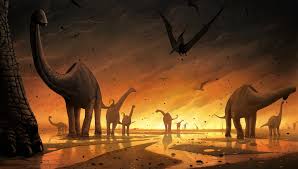An asteroid or comet impact 66 million years ago reignited massive volcanic eruptions in India, and may have contributed to the dinosaurs’ extinction at the end of the Cretaceous period, finds a study.
In the study, scientists from the University of California – Berkeley, report that the million-year sequence of eruptions spewed lava flows for distances of at least 500 km across the Indian continent, creating the so-called Deccan Traps flood basalts that in some places are nearly 2 km thick.
“Now that we have dated Deccan Traps lava flows in more and different locations, we see that the transition seems to be the same everywhere.

“I would say, with pretty high confidence, that the eruptions occurred within 50,000 years, and maybe 30,000 years, of the impact, which means they were synchronous within the margin of error,” said Paul Renne, Professor at UC Berkeley.
“That is an important validation of the hypothesis that the impact renewed lava flows.”
The new dates also confirm earlier estimates that the lava flows continued for about a million years, but contain a surprise: three-quarters of the lava erupted after the impact, according to the study published in the Science journal.
Previous studies suggested that about 80 percent of the lava erupted before the impact.
If most of the Deccan Traps lava had erupted before the impact, then gases emitted during the eruptions could have been the cause of global warming within the last 400,000 years of the Cretaceous Period, during which temperatures increased, on average, about 8 degrees Celsius.
During this period of warming, species would have evolved suited to hothouse conditions, only to be confronted by global cooling from the dust or by climate cooling gases caused by either the impact or the volcanoes.
The cold would have been a shock from which most creatures would never have recovered, disappearing entirely from the fossil record leading to a mass extinction, they explained.




